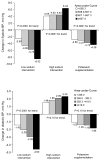Association between blood pressure responses to the cold pressor test and dietary sodium intervention in a Chinese population
- PMID: 18779460
- PMCID: PMC2535851
- DOI: 10.1001/archinte.168.16.1740
Association between blood pressure responses to the cold pressor test and dietary sodium intervention in a Chinese population
Abstract
Background: Blood pressure (BP) responses to the cold pressor test (CPT) and to dietary sodium intake might be related to the risk of hypertension. We examined the association between BP responses to the CPT and to dietary sodium and potassium interventions.
Methods: The CPT and dietary intervention were conducted among 1906 study participants in rural China. The dietary intervention included three 7-day periods of low sodium intake (3 g/d of salt [sodium chloride] [51.3 mmol/d of sodium]), high sodium intake (18 g/d of salt [307.8 mmol/d of sodium]), and high sodium intake plus potassium chloride supplementation (60 mmol/d). A total of 9 BP measurements were obtained during the 3-day baseline observation and the last 3 days of each intervention using a random-zero sphygmomanometer.
Results: Blood pressure response to the CPT was significantly associated with BP changes during the sodium and potassium interventions (all P < .001). Compared with the lowest quartile of BP response to the CPT (quartile 1), systolic BP changes (95% confidence intervals) for the quartiles 2, 3, and 4 were -2.02 (-2.87 to -1.16) mm Hg, -3.17 (-4.05 to -2.28) mm Hg, and -5.98 (-6.89 to -5.08) mm Hg, respectively, during the low-sodium intervention. Corresponding systolic BP changes during the high-sodium intervention were 0.40 (-0.36 to 1.16) mm Hg, 0.44 (-0.35 to 1.22) mm Hg, and 2.30 (1.50 to 3.10) mm Hg, respectively, and during the high-sodium plus potassium supplementation intervention were -0.26 (-0.99 to 0.46) mm Hg, -0.95 (-1.70 to -0.20) mm Hg, and -1.59 (-2.36 to -0.83) mm Hg, respectively.
Conclusions: These results indicate that BP response to the CPT was associated with salt sensitivity and potassium sensitivity. Furthermore, a low-sodium or high-potassium diet might be more effective to lower BP among individuals with high responses to the CPT.
Figures



Comment in
-
The cold pressor test: a new predictor of future hypertension?Arch Intern Med. 2008 Sep 8;168(16):1732. doi: 10.1001/archinte.168.16.1732. Arch Intern Med. 2008. PMID: 18779458 No abstract available.
References
-
- Hajjar I, Kotchen TA. Trends in prevalence, awareness, treatment, and control of hypertension in the United States, 1988–2000. JAMA. 2003;290:199–206. - PubMed
-
- Kearney PM, Whelton M, Reynolds K, Muntner P, Whelton PK, He J. Global burden of hypertension: analysis of worldwide data. Lancet. 2005;365:217–23. - PubMed
-
- He J, Whelton PK. Salt intake, hypertension and risk of cardiovascular disease: an important public health challenge. Int J Epidemiol. 2002;31:327–31. - PubMed
-
- Jones DW. Dietary sodium and blood pressure. Hypertension. 2004;43:932–5. - PubMed
-
- Whelton PK, He J, Cutler JA, Brancati FL, Appel LJ, Follmann D, Klag MJ. Effects of oral potassium on blood pressure. Meta-analysis of randomized controlled clinical trials. JAMA. 1997;277:1624–32. - PubMed
Publication types
MeSH terms
Substances
Grants and funding
LinkOut - more resources
Full Text Sources
Medical
Molecular Biology Databases

